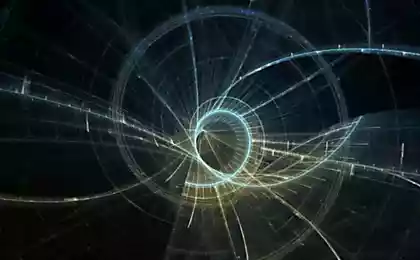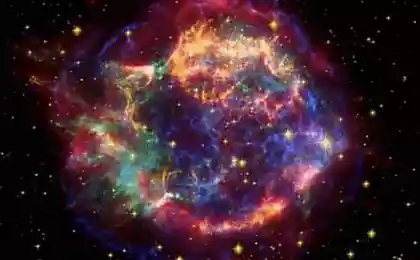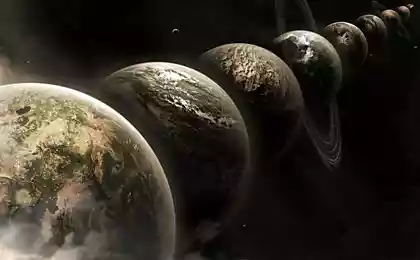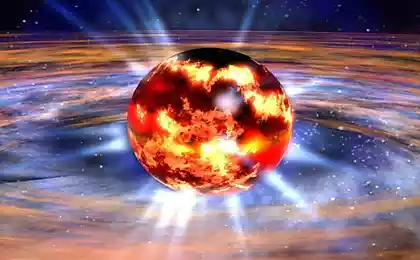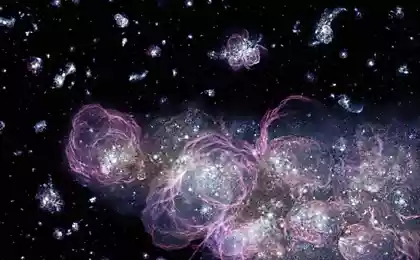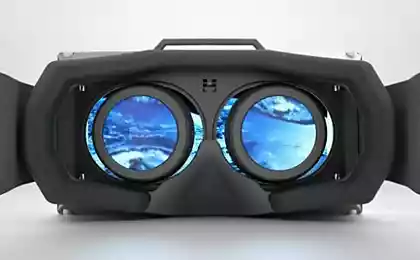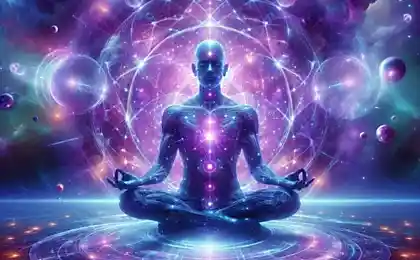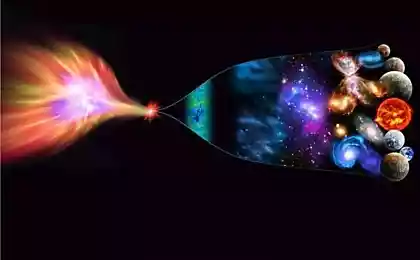857
10 reasons our universe a virtual reality
Physical realism is the view that the physical world we see is real and exists by itself. Most people think that this goes without saying, but for some time the physical realism seriously contradict some of the facts from the world of physics. The paradoxes that baffled physicists of the last century, is still not resolved, and a promising string theory and supersymmetry nowhere this who has not yet brought.
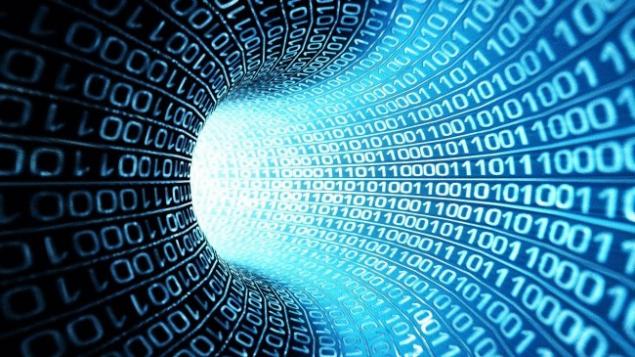
In contrast, quantum theory works, but quantum waves that entangle, be in a state of superposition, and then quanta collapse into the dark, seem physically impossible — they seem to be "imaginary".All this results in an interesting picture: the theory that does not exist, effectively predicts that there is — but how can the unreal predict the real?
Quantum realism is the opposite view, according to which the quantum world is real and creates the physical world as a virtual reality. Quantum mechanics therefore predicts the effects of physical mechanics, because it is its cause. Physicists say that to believe that quantum States don't exist, it's like "pay no attention to that man behind the curtain."
Quantum realism is not "the matrix" in which another world that created our physical. And it's not the idea of brain-in-VAT, as this virtuality was long before man appeared. And it's not a phantom of another world, which affects our: our physical world is the phantom itself. In physical realism, the quantum world does not exist, but in quantum realism the physical world is impossible — unless it is virtual reality. And here is a possible explanation.
The Emergence Of The Universe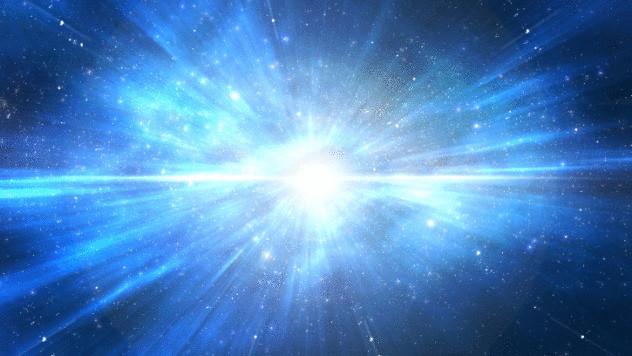
Physical realism
Everyone has heard about the Big Bang, but if the physical universe in front of us, how did it start? Completed the universe should not change at all as she had nowhere to go and nowhere to come, and nothing can change it. However, in 1929 astronomer Edwin Hubble discovered that all galaxies are expanding away from us that led to thoughts about the Big Bang, which happened at the point of space-time about 14 billion years ago. The discovery of the cosmic microwave background (which can be seen in the form of white noise on the TV screen) has confirmed that our universe not only began at the point, but space and time appeared along with it.
So, when the universe was created, it already existed before his creation, which is impossible, or was created by something else. Can not be that a whole, complete and whole universe appeared by itself out of nothing. However, in this strange idea to believe most physicists today. They believe that the first event was a quantum fluctuation in the vacuum (in quantum mechanics, pairs of particles and antiparticles appear and disappear everywhere, that is absolute emptiness does not exist). But if the matter just appeared from space, where did space? As a quantum fluctuation in space could create space? How could the time start to go by itself?
Quantum realism
Every virtual reality begins with first event which appears both space and time. From this point of view, the Big Bang happened when our physical universe is loaded, including the operating system of space-time. Quantum realism suggests that the Big Bang was in fact a Great Start.
Our Universe has a maximum speed of
Physical realism
Einstein came to the conclusion that nothing can travel faster than light in vacuum, and over time it has become a universal constant, however, it is unclear why. Roughly speaking, any explanation comes down to the fact that "the speed of light is constant and limit, because this is how". Because nothing can be straighter direct.
But the answer to the question "why things can't move faster and faster", which sounds like "because I can", is hardly satisfactory. Light is slowed down (refracted) by the water or glass, and when it moves in the water, we say its medium is water, when the glass — glass, but when it moves in empty space, we are silent. How can a wave vibrating in the void? There is no physical Foundation for the movement of light in the vacuum of space, not to mention determining the maximum possible speed.
Quantum realism
If the physical world is a virtual reality, the speed of light is a product of information processing. Information is defined as sampling from a nite set, so its treatment must also be carried out with a finite speed, and thus, our world is refreshed with a finite speed. Conditional processor supercomputer updated about 10 quadrillion times per second, and our universe is updated trillions of times faster, but the principles are basically the same. And if the screen image has pixels and a refresh rate, our world has Planck length and Planck time.
In this case, the speed of light is the ultimate, because the network can't transmit anything faster than one pixel per cycle-i.e., Planck length per unit of Planck time, or about 300,000 kilometers per second. The speed of light in reality should be called the speed of space (space).
Our time is very malleable
Physical realism
In Einstein's twin paradox, one of them travels in a rocket at nearly the speed of light and returns a year later to find that his twin brother is eighty years old. None of them knew that their time is different, and all survived, but the life of one coming to an end and another just beginning. In objective reality it seems impossible, but the time for the particles in accelerators really slows down. In the 1970s, scientists have launched around the world atomic clocks on aircraft, to confirm that those ticking slower than they initially synchronized clocks on earth. But as the time, the judge of all the changes, can itself be subject to change?
Quantum realism
Virtual reality is dependent on virtual time, where each processing cycle is one "tick". Every gamer knows that when the computer freezes due to lag, playing time, too little slows down. Similarly, in our world time slows down with increasing speed or near massive objects, which indicates the potentiality. The twin on the rocket have aged only a year, because all the cycles of processing system podvisli in order to save. Only changed its virtual time.
Our space is curved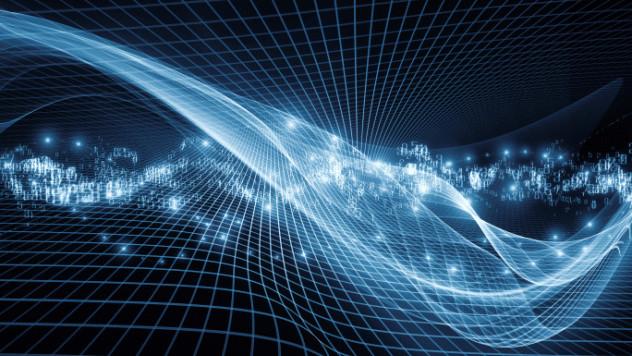
Physical realism
According to the General theory of relativity, the Sun keeps the Earth in orbit by curving space, but how space can be bent? In space, by definition, is a movement, so that it was bent it must exist in another space, and so on to infinity. If matter exists in the space of emptiness, nothing can move or bend that space.
Quantum realism
In the "idle" computer is not actually idle, and performs the zero program and our space can do the same. The Casimir effect occurs when the vacuum of space exerts pressure on the two plates, which are located close to each other. Modern physics States that the pressure cause the virtual particles that appear from nowhere, but in quantum realism empty space is filled treatment, which causes the same effect. And space as a processing network that can represent a three-dimensional surface is able to bend.
Accidents happen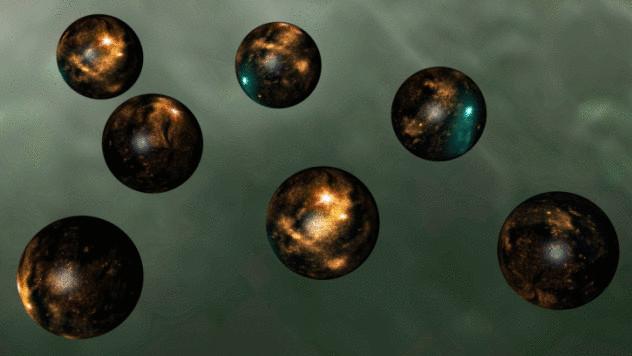
Physical realism
In quantum theory quantum collapse is random, for example, a radioactive atom can emit a photon when it wants. Classical physics doesn't explain the randomness of events. Quantum theory explains the physical event a "collapse of the wave function", so every physical event has an element of randomness.
To prevent a threat to this primacy of physical causation, in 1957 Hugh Everett proposed the "many-worlds" theory, untestable idea that every quantum choice spawns a new universe, so every event takes place somewhere in the new "multiple universe" (multiverse). For example, if you chose sandwiches for Breakfast, nature creates another universe in which you eat peaches and yogurt. Initially, the "many-worlds" interpretation, treated with laughter, but today, physicists often prefer this theory to others, to dispel the nightmare of accidents.
However, if quantum events create new universes, it is easy to guess that the universes will accumulate at a rate that transcends any notions of infinity. Many-worlds imagination not simply shy away from Occam's razor, but also abused her. Besides the multiple universe is a reincarnation of the other old tales of the clockwork universe (clockwork universe) that quantum theory was debunked in the last century. False theories don't die, they turn to zombies.
Quantum realism
The processor in the online game can generate a random value, and our world — too. Quantum events are random, as they are related to client-server actions, for which we have no access to. Quantum randomness seems pointless, but plays the same role in the evolution of matter, what kind of genetic accident played in biological evolution.
Antimatter exists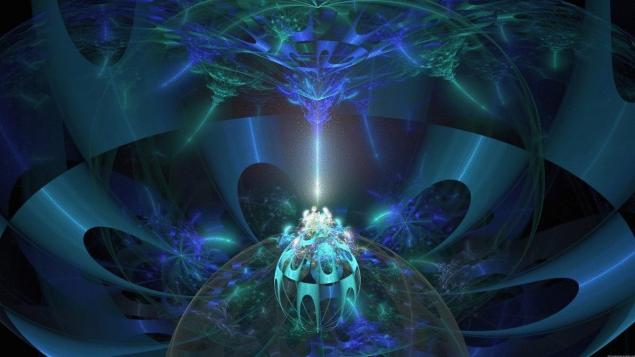
Physical realism
Antimatter refers to sub-atomic particles corresponding to electrons, protons and neutrons of ordinary matter but opposite electric charge and other properties. In our Universe, negative electrons orbit positive atomic nuclei. In the universe of antimatter positive electron would have revolved around negative nuclei, but the inhabitants of this universe it would seem that with physical laws all right. Matter and antimatter annihilate upon contact, that is, they cancel each other out.
Equation Paul Dirac predicted antimatter before its discovery, but it was not clear how something annihilating matter, even possible. The Feynman diagram of the meeting of an electron with an antielectron shows that the latter, when he goes back in time! As is often the case in modern physics, this equation works, but its consequences have no meaning. Matter does not need the antipode, and reverse the passage of time undermines the causal foundations of physics. Antimatter is one of the most mysterious discoveries of modern physics.
Quantum realism
If matter is the result of processing, and processing sets the sequence of values, it follows that these values can be reversed, having thus, antibrand. In this light, antimatter is the inevitable by-product of matter created in the process. If time is the completion of primary cycles of matter for antimatter, it will complete the secondary cycles, which means that it will go in the opposite direction. From matter is the antithesis, because the process that creates it is reversible, and anteprima exists for the same reason. Only virtual time may go backwards.
The double-slit experiment
Physical realism
Over 200 years ago, Thomas young performed an experiment that still baffles physicists missed the light through two parallel slits to get an interference pattern on the screen. Only waves can do this, so the particle of light (even single photon) must be a wave. But the light can get to the screen in the form of points that can happen only if the photon particle.
To test this, physicists sent one photon through the slits of young. One photon gave the expected point of impact of particles, but soon the dots lined up in the interference pattern. The effect does not depend on time: a single photon passing through the slits each year gives the same pattern. No the photon doesn't know where got previous, as does the interference pattern? Detectors are placed at each slit, only to have wasted time — the photon goes either through one slit or through the other, never through both. Nature mocks us: when we are not watching, the photon — wave when you look particle.
Modern physics calls this the mystery of wave-particle duality, "deeply strange" phenomenon, explainable only esoteric equations of non-existent waves. Nevertheless, we, the sane people know that a point particle cannot propagate like waves, and waves can't be particles.
Quantum realism
Quantum theory explains young's experiment with fictitious waves that pass through both slits, interfere, and then quanta collapse into the dark point on the screen. It works, but the waves that do not exist, can not explain the fact that there is. In quantum realism, a photon program can spread in the network like a wave, and then start again when the node is overloaded and reboots, like a particle. What we call physical reality, is a series of reboots, explaining and quantum waves and quantum collapse.
Dark energy and dark matter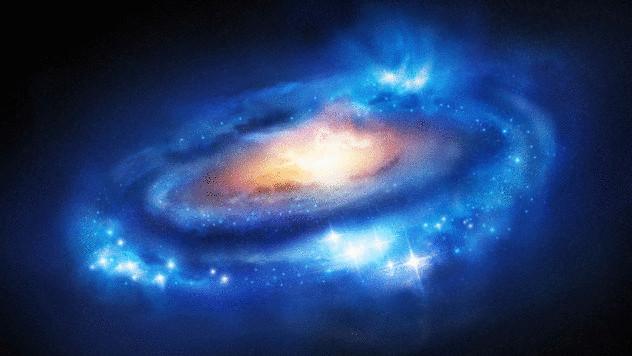
Physical realism
Modern physics describes the matter we see, but the Universe also has five times more of what is called dark matter. It can be detected as a halo around the black hole at the center of our galaxy that binds the star together more strongly than can afford their gravity. It does not matter that we can see because light does not take it; it is not antimatter, because it has no signatures of gamma-radiation; it is not a black hole, because there is no effect of gravitational lensing without dark matter stars in our galaxy would fly away.
None of the known particles does not describe dark matter, proposed hypothetical particles known as weakly interacting massive particles (WIMP, or "wimpy"), but neither one of them was never found, despite a thorough search. In addition, 70% of the Universe presents dark energy, which physics cannot explain. Dark energy is a sort of negative gravity, the weak effect that pushes things, accelerating the expansion of the Universe. It is not much change over time, but something floating in an expanding space over time should subside. If it were a property of space, it would have increased with the expansion of space. At the moment no one has the slightest idea what dark energy is.
Quantum realism
If empty space is null processing, "hibernate", then it is not empty, and if it expands, the empty space is constantly added. New treatment is, by definition, accept input, but do not give any output. So they absorb but do not emit, just like the negative effect we call dark energy. If new space adds at a constant rate, the effect will not be much change over time, so dark energy is due to the ongoing creation of space. Quantum realism suggests that the particles that can explain dark energy and dark matter will not be detected.
Tunnelling электроны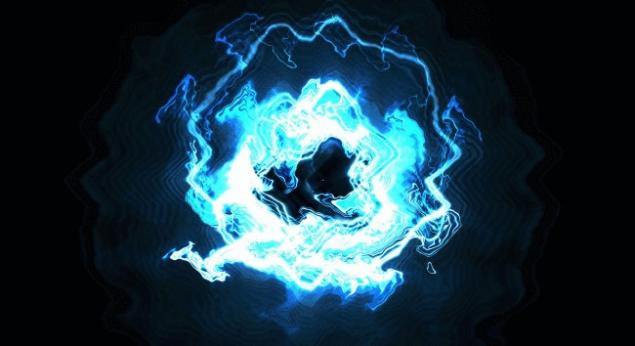
Physical realism
In our world, an electron can suddenly pop up outside a Gaussian field, through which can not penetrate. This can be compared with a coin in a perfectly sealed glass bottle suddenly appearing outside it. In a purely physical world it is simply impossible, but in our — quite.
Quantum realism
Quantum theory suggests that the electron should accidentally do the above, because the quantum wave can spread regardless of physical barriers, and the electron can suddenly collapse at any point. Every collapse is a shot of the movie we call physical reality, except that the next frame is not fixed, but is based on probability. An electron "tunnelling" through an impenetrable field is like a film, which conceals from view, as the player comes out.
It may seem odd, but teleporting from one state to another is like moving the entire quantum matter. We see the physical world, which exists independently of our observation, but quantum theory, the observer effect describes the effect in-game when you look to the left, creates a single view when right — another. In theory Bohm quantum Ghost wave guides the electron, but in the theory we are considering, the electron is the ghostly wave. Quantum realism resolves the paradox of quantum, making the quantum world is real and the physical world is a product of it.
Quantum запутанность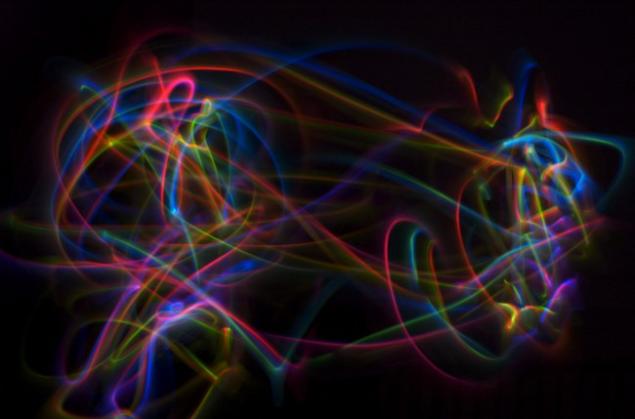
Physical realism
If a cesium atom emits two photons in different directions, quantum theory "confuses" them, so if one is spinning upward, the other downward. But if one accidentally flips as the other can instantly learn about it, at any distance? For Einstein the discovery that measuring the spin of one photon instantaneously determines the spin of the other, wherever it was in the Universe was "spooky action at a distance". Experimental verification of this became one of the most careful and accurate experiments of the General history of science, and quantum theory was once again right. The observation of a confusing one photon causes the other gets the opposite spin — even if they are too far even for the light signal had them inform about it. Nature could do so, that the spin of one photon would be upper and the other lower, from the start, but this, apparently, was too difficult. So she let the back one to choose any random direction, so that when we measure it and define one spin of the other photon immediately changes to the opposite, though that seems physically impossible.
Quantum realism
From this point of view, two photons entangle when their programs are combined for the joint conduct of two points. If one program is responsible for top spin, and the other for the bottom, their Union will be responsible for both pixels, wherever they were. The physical fact of each pixel randomly restarts the program, the other program responds accordingly. This code ignores the redistribution of distance because the processor does not need to go to pixel, to ask him to roll over, even if the screen is big as the universe itself.
The standard model of physics includes the 61 fundamental particles with established parameters of charge and mass. If she were a car she'd have a few dozen levers to run each particle. Also, it would take five invisible fields to spawn 14 virtual particles with 16 different "charges" to work. You may think this a complete set, but the Standard model can't explain gravity, the stability of the proton, antimatter, changes of quarks, the neutrino mass or spin, inflation, or quantum randomness — and this is very important questions. Not to mention the particles of dark matter and dark energy that comprise most of the Universe.
Quantum realism new interpreterpath the equations of quantum theory in terms of one network and one program. Its main assumption is that the physical world is a processing output, but this does not detract from its reality — we just don't see it. Theory suggests that the matter appeared from the light as a stable quantum wave, and therefore quantum realism suggests that light in a vacuum can produce matter in a collision. The standard model says that photons can't collide, so you need a radically experimental approach to test the virtual reality of our world. When the light in the vacuum will give rise to matter in the collision model of elementary particles is replaced by the model of information processing.
For the record: Brian Whitworth, Creator of the theory of quantum realism, leave a detailed guide to the terms.
P. S. And remember, only by changing their consumption — together we change the world! ©
Source: hi-news.ru

In contrast, quantum theory works, but quantum waves that entangle, be in a state of superposition, and then quanta collapse into the dark, seem physically impossible — they seem to be "imaginary".All this results in an interesting picture: the theory that does not exist, effectively predicts that there is — but how can the unreal predict the real?
Quantum realism is the opposite view, according to which the quantum world is real and creates the physical world as a virtual reality. Quantum mechanics therefore predicts the effects of physical mechanics, because it is its cause. Physicists say that to believe that quantum States don't exist, it's like "pay no attention to that man behind the curtain."
Quantum realism is not "the matrix" in which another world that created our physical. And it's not the idea of brain-in-VAT, as this virtuality was long before man appeared. And it's not a phantom of another world, which affects our: our physical world is the phantom itself. In physical realism, the quantum world does not exist, but in quantum realism the physical world is impossible — unless it is virtual reality. And here is a possible explanation.
The Emergence Of The Universe

Physical realism
Everyone has heard about the Big Bang, but if the physical universe in front of us, how did it start? Completed the universe should not change at all as she had nowhere to go and nowhere to come, and nothing can change it. However, in 1929 astronomer Edwin Hubble discovered that all galaxies are expanding away from us that led to thoughts about the Big Bang, which happened at the point of space-time about 14 billion years ago. The discovery of the cosmic microwave background (which can be seen in the form of white noise on the TV screen) has confirmed that our universe not only began at the point, but space and time appeared along with it.
So, when the universe was created, it already existed before his creation, which is impossible, or was created by something else. Can not be that a whole, complete and whole universe appeared by itself out of nothing. However, in this strange idea to believe most physicists today. They believe that the first event was a quantum fluctuation in the vacuum (in quantum mechanics, pairs of particles and antiparticles appear and disappear everywhere, that is absolute emptiness does not exist). But if the matter just appeared from space, where did space? As a quantum fluctuation in space could create space? How could the time start to go by itself?
Quantum realism
Every virtual reality begins with first event which appears both space and time. From this point of view, the Big Bang happened when our physical universe is loaded, including the operating system of space-time. Quantum realism suggests that the Big Bang was in fact a Great Start.
Our Universe has a maximum speed of

Physical realism
Einstein came to the conclusion that nothing can travel faster than light in vacuum, and over time it has become a universal constant, however, it is unclear why. Roughly speaking, any explanation comes down to the fact that "the speed of light is constant and limit, because this is how". Because nothing can be straighter direct.
But the answer to the question "why things can't move faster and faster", which sounds like "because I can", is hardly satisfactory. Light is slowed down (refracted) by the water or glass, and when it moves in the water, we say its medium is water, when the glass — glass, but when it moves in empty space, we are silent. How can a wave vibrating in the void? There is no physical Foundation for the movement of light in the vacuum of space, not to mention determining the maximum possible speed.
Quantum realism
If the physical world is a virtual reality, the speed of light is a product of information processing. Information is defined as sampling from a nite set, so its treatment must also be carried out with a finite speed, and thus, our world is refreshed with a finite speed. Conditional processor supercomputer updated about 10 quadrillion times per second, and our universe is updated trillions of times faster, but the principles are basically the same. And if the screen image has pixels and a refresh rate, our world has Planck length and Planck time.
In this case, the speed of light is the ultimate, because the network can't transmit anything faster than one pixel per cycle-i.e., Planck length per unit of Planck time, or about 300,000 kilometers per second. The speed of light in reality should be called the speed of space (space).
Our time is very malleable

Physical realism
In Einstein's twin paradox, one of them travels in a rocket at nearly the speed of light and returns a year later to find that his twin brother is eighty years old. None of them knew that their time is different, and all survived, but the life of one coming to an end and another just beginning. In objective reality it seems impossible, but the time for the particles in accelerators really slows down. In the 1970s, scientists have launched around the world atomic clocks on aircraft, to confirm that those ticking slower than they initially synchronized clocks on earth. But as the time, the judge of all the changes, can itself be subject to change?
Quantum realism
Virtual reality is dependent on virtual time, where each processing cycle is one "tick". Every gamer knows that when the computer freezes due to lag, playing time, too little slows down. Similarly, in our world time slows down with increasing speed or near massive objects, which indicates the potentiality. The twin on the rocket have aged only a year, because all the cycles of processing system podvisli in order to save. Only changed its virtual time.
Our space is curved

Physical realism
According to the General theory of relativity, the Sun keeps the Earth in orbit by curving space, but how space can be bent? In space, by definition, is a movement, so that it was bent it must exist in another space, and so on to infinity. If matter exists in the space of emptiness, nothing can move or bend that space.
Quantum realism
In the "idle" computer is not actually idle, and performs the zero program and our space can do the same. The Casimir effect occurs when the vacuum of space exerts pressure on the two plates, which are located close to each other. Modern physics States that the pressure cause the virtual particles that appear from nowhere, but in quantum realism empty space is filled treatment, which causes the same effect. And space as a processing network that can represent a three-dimensional surface is able to bend.
Accidents happen

Physical realism
In quantum theory quantum collapse is random, for example, a radioactive atom can emit a photon when it wants. Classical physics doesn't explain the randomness of events. Quantum theory explains the physical event a "collapse of the wave function", so every physical event has an element of randomness.
To prevent a threat to this primacy of physical causation, in 1957 Hugh Everett proposed the "many-worlds" theory, untestable idea that every quantum choice spawns a new universe, so every event takes place somewhere in the new "multiple universe" (multiverse). For example, if you chose sandwiches for Breakfast, nature creates another universe in which you eat peaches and yogurt. Initially, the "many-worlds" interpretation, treated with laughter, but today, physicists often prefer this theory to others, to dispel the nightmare of accidents.
However, if quantum events create new universes, it is easy to guess that the universes will accumulate at a rate that transcends any notions of infinity. Many-worlds imagination not simply shy away from Occam's razor, but also abused her. Besides the multiple universe is a reincarnation of the other old tales of the clockwork universe (clockwork universe) that quantum theory was debunked in the last century. False theories don't die, they turn to zombies.
Quantum realism
The processor in the online game can generate a random value, and our world — too. Quantum events are random, as they are related to client-server actions, for which we have no access to. Quantum randomness seems pointless, but plays the same role in the evolution of matter, what kind of genetic accident played in biological evolution.
Antimatter exists

Physical realism
Antimatter refers to sub-atomic particles corresponding to electrons, protons and neutrons of ordinary matter but opposite electric charge and other properties. In our Universe, negative electrons orbit positive atomic nuclei. In the universe of antimatter positive electron would have revolved around negative nuclei, but the inhabitants of this universe it would seem that with physical laws all right. Matter and antimatter annihilate upon contact, that is, they cancel each other out.
Equation Paul Dirac predicted antimatter before its discovery, but it was not clear how something annihilating matter, even possible. The Feynman diagram of the meeting of an electron with an antielectron shows that the latter, when he goes back in time! As is often the case in modern physics, this equation works, but its consequences have no meaning. Matter does not need the antipode, and reverse the passage of time undermines the causal foundations of physics. Antimatter is one of the most mysterious discoveries of modern physics.
Quantum realism
If matter is the result of processing, and processing sets the sequence of values, it follows that these values can be reversed, having thus, antibrand. In this light, antimatter is the inevitable by-product of matter created in the process. If time is the completion of primary cycles of matter for antimatter, it will complete the secondary cycles, which means that it will go in the opposite direction. From matter is the antithesis, because the process that creates it is reversible, and anteprima exists for the same reason. Only virtual time may go backwards.
The double-slit experiment
Physical realism
Over 200 years ago, Thomas young performed an experiment that still baffles physicists missed the light through two parallel slits to get an interference pattern on the screen. Only waves can do this, so the particle of light (even single photon) must be a wave. But the light can get to the screen in the form of points that can happen only if the photon particle.
To test this, physicists sent one photon through the slits of young. One photon gave the expected point of impact of particles, but soon the dots lined up in the interference pattern. The effect does not depend on time: a single photon passing through the slits each year gives the same pattern. No the photon doesn't know where got previous, as does the interference pattern? Detectors are placed at each slit, only to have wasted time — the photon goes either through one slit or through the other, never through both. Nature mocks us: when we are not watching, the photon — wave when you look particle.
Modern physics calls this the mystery of wave-particle duality, "deeply strange" phenomenon, explainable only esoteric equations of non-existent waves. Nevertheless, we, the sane people know that a point particle cannot propagate like waves, and waves can't be particles.
Quantum realism
Quantum theory explains young's experiment with fictitious waves that pass through both slits, interfere, and then quanta collapse into the dark point on the screen. It works, but the waves that do not exist, can not explain the fact that there is. In quantum realism, a photon program can spread in the network like a wave, and then start again when the node is overloaded and reboots, like a particle. What we call physical reality, is a series of reboots, explaining and quantum waves and quantum collapse.
Dark energy and dark matter

Physical realism
Modern physics describes the matter we see, but the Universe also has five times more of what is called dark matter. It can be detected as a halo around the black hole at the center of our galaxy that binds the star together more strongly than can afford their gravity. It does not matter that we can see because light does not take it; it is not antimatter, because it has no signatures of gamma-radiation; it is not a black hole, because there is no effect of gravitational lensing without dark matter stars in our galaxy would fly away.
None of the known particles does not describe dark matter, proposed hypothetical particles known as weakly interacting massive particles (WIMP, or "wimpy"), but neither one of them was never found, despite a thorough search. In addition, 70% of the Universe presents dark energy, which physics cannot explain. Dark energy is a sort of negative gravity, the weak effect that pushes things, accelerating the expansion of the Universe. It is not much change over time, but something floating in an expanding space over time should subside. If it were a property of space, it would have increased with the expansion of space. At the moment no one has the slightest idea what dark energy is.
Quantum realism
If empty space is null processing, "hibernate", then it is not empty, and if it expands, the empty space is constantly added. New treatment is, by definition, accept input, but do not give any output. So they absorb but do not emit, just like the negative effect we call dark energy. If new space adds at a constant rate, the effect will not be much change over time, so dark energy is due to the ongoing creation of space. Quantum realism suggests that the particles that can explain dark energy and dark matter will not be detected.
Tunnelling электроны

Physical realism
In our world, an electron can suddenly pop up outside a Gaussian field, through which can not penetrate. This can be compared with a coin in a perfectly sealed glass bottle suddenly appearing outside it. In a purely physical world it is simply impossible, but in our — quite.
Quantum realism
Quantum theory suggests that the electron should accidentally do the above, because the quantum wave can spread regardless of physical barriers, and the electron can suddenly collapse at any point. Every collapse is a shot of the movie we call physical reality, except that the next frame is not fixed, but is based on probability. An electron "tunnelling" through an impenetrable field is like a film, which conceals from view, as the player comes out.
It may seem odd, but teleporting from one state to another is like moving the entire quantum matter. We see the physical world, which exists independently of our observation, but quantum theory, the observer effect describes the effect in-game when you look to the left, creates a single view when right — another. In theory Bohm quantum Ghost wave guides the electron, but in the theory we are considering, the electron is the ghostly wave. Quantum realism resolves the paradox of quantum, making the quantum world is real and the physical world is a product of it.
Quantum запутанность

Physical realism
If a cesium atom emits two photons in different directions, quantum theory "confuses" them, so if one is spinning upward, the other downward. But if one accidentally flips as the other can instantly learn about it, at any distance? For Einstein the discovery that measuring the spin of one photon instantaneously determines the spin of the other, wherever it was in the Universe was "spooky action at a distance". Experimental verification of this became one of the most careful and accurate experiments of the General history of science, and quantum theory was once again right. The observation of a confusing one photon causes the other gets the opposite spin — even if they are too far even for the light signal had them inform about it. Nature could do so, that the spin of one photon would be upper and the other lower, from the start, but this, apparently, was too difficult. So she let the back one to choose any random direction, so that when we measure it and define one spin of the other photon immediately changes to the opposite, though that seems physically impossible.
Quantum realism
From this point of view, two photons entangle when their programs are combined for the joint conduct of two points. If one program is responsible for top spin, and the other for the bottom, their Union will be responsible for both pixels, wherever they were. The physical fact of each pixel randomly restarts the program, the other program responds accordingly. This code ignores the redistribution of distance because the processor does not need to go to pixel, to ask him to roll over, even if the screen is big as the universe itself.
The standard model of physics includes the 61 fundamental particles with established parameters of charge and mass. If she were a car she'd have a few dozen levers to run each particle. Also, it would take five invisible fields to spawn 14 virtual particles with 16 different "charges" to work. You may think this a complete set, but the Standard model can't explain gravity, the stability of the proton, antimatter, changes of quarks, the neutrino mass or spin, inflation, or quantum randomness — and this is very important questions. Not to mention the particles of dark matter and dark energy that comprise most of the Universe.
Quantum realism new interpreterpath the equations of quantum theory in terms of one network and one program. Its main assumption is that the physical world is a processing output, but this does not detract from its reality — we just don't see it. Theory suggests that the matter appeared from the light as a stable quantum wave, and therefore quantum realism suggests that light in a vacuum can produce matter in a collision. The standard model says that photons can't collide, so you need a radically experimental approach to test the virtual reality of our world. When the light in the vacuum will give rise to matter in the collision model of elementary particles is replaced by the model of information processing.
For the record: Brian Whitworth, Creator of the theory of quantum realism, leave a detailed guide to the terms.
P. S. And remember, only by changing their consumption — together we change the world! ©
Source: hi-news.ru

